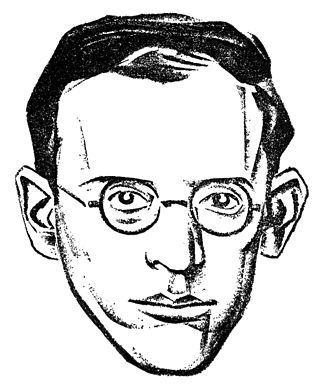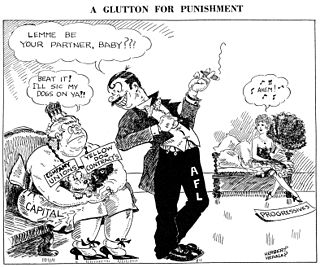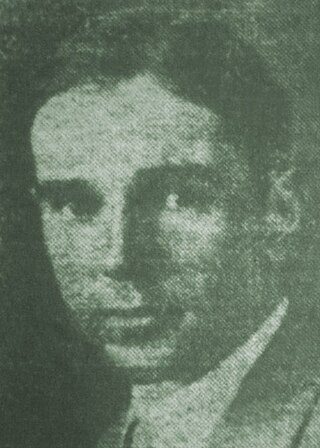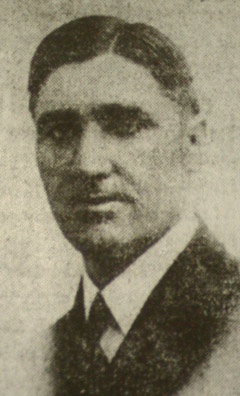
John Llewellyn Lewis was an American leader of organized labor who served as president of the United Mine Workers of America (UMW) from 1920 to 1960. A major player in the history of coal mining, he was the driving force behind the founding of the Congress of Industrial Organizations (CIO), which established the United Steel Workers of America and helped organize millions of other industrial workers in the 1930s, during the Great Depression. After resigning as head of the CIO in 1941, thus keeping his promise of resignation if President Franklin Delano Roosevelt won the 1940 election against Wendell Willkie, Lewis took the United Mine Workers out of the CIO in 1942 and in 1944 took the union into the American Federation of Labor (AFL).

The United Mine Workers of America is a North American labor union best known for representing coal miners. Today, the Union also represents health care workers, truck drivers, manufacturing workers and public employees in the United States and Canada. Although its main focus has always been on workers and their rights, the UMW of today also advocates for better roads, schools, and universal health care. By 2014, coal mining had largely shifted to open pit mines in Wyoming, and there were only 60,000 active coal miners. The UMW was left with 35,000 members, of whom 20,000 were coal miners, chiefly in underground mines in Kentucky and West Virginia. However it was responsible for pensions and medical benefits for 40,000 retired miners, and for 50,000 spouses and dependents.
The Communist Party USA and its allies played an important role in the United States labor movement, particularly in the 1930s and 1940s, but wasn't successful either in bringing the labor movement around to its agenda of fighting for socialism and full workers' control over industry, or in converting their influence in any particular union into membership gains for the Party. The CP has had only negligible influence in labor since its supporters' defeat in internal union political battles in the aftermath of World War II and the CIO's expulsion of the unions in which they held the most influence in 1950. After the expulsion of the Communists, organized labor in the United States began a steady decline.

William Z. Foster was a radical American labor organizer and Communist politician, whose career included serving as General Secretary of the Communist Party USA from 1945 to 1957. He was previously a member of the Socialist Party of America and the Industrial Workers of the World, leading the drive to organize packinghouse industry workers during World War I and the steel strike of 1919.

Philip Murray was a Scottish-born steelworker and an American labor leader. He was the first president of the Steel Workers Organizing Committee (SWOC), the first president of the United Steelworkers of America (USWA), and the longest-serving president of the Congress of Industrial Organizations (CIO).

The Red International of Labor Unions, commonly known as the Profintern, was an international body established by the Communist International (Comintern) with the aim of coordinating communist activities within trade unions. Formally established in 1921, the Profintern aimed to act as a counterweight to the influence of the so-called "Amsterdam International", the social-democratic International Federation of Trade Unions, an organization which the Comintern branded as "class-collaborationist" and as an impediment to revolution. After entering a period of decline in the middle 1930s, the Profintern was finally dissolved in 1937 with the advent of Comintern's "Popular Front" policy.

The Harlan County War, or Bloody Harlan, was a series of coal industry skirmishes, executions, bombings and strikes that took place in Harlan County, Kentucky, during the 1930s. The incidents involved coal miners and union organizers on one side and coal firms and law enforcement officials on the other. The Harlan County coal miners campaigned and fought to organize their workplaces and better their wages and working conditions. It was a nearly decade-long conflict, lasting from 1931 to 1939. Before its conclusion, an unknown number of miners, deputies and bosses would be killed, state and federal troops would occupy the county more than half a dozen times, two acclaimed folk singers would emerge, union membership would oscillate wildly and workers in the nation's most anti-labor coal county would ultimately be represented by a union.

The Workers' Unity League (WUL) was established in January 1930 as a militant industrial union labour central closely related to the Communist Party of Canada on the instructions of the Communist International.
The Progressive Miners of America was a coal miners' union organized in 1932 in downstate Illinois. It was formed in response to a 1932 contract proposal negotiated by United Mine Workers President John L. Lewis, which reduced wages from a previous rate of $6.10 per day to $5.00 per day.

Albert Weisbord (1900–1977) was an American political activist and union organizer. He is best remembered, along his wife Vera Buch, as one of the primary union organizers of the seminal 1926 Passaic Textile Strike and as the founder of a small Trotskyist political organization of the 1930s called the Communist League of Struggle.

The Conference for Progressive Labor Action (CPLA) was a left-wing American political organization established in May 1929 by A. J. Muste, the director of Brookwood Labor College. The organization was established to promote industrial unionism and to work for reform of the American Federation of Labor. It dissolved itself in December 1933 to form the American Workers Party.
The Trade Union Unity League (TUUL) was an industrial union umbrella organization under the Communist Party of the United States (CPUSA) between 1929 and 1935. The group was an American affiliate of the Red International of Labor Unions. The formation of the TUUL was the result of the Communist International's Third Period policy, which ordered affiliated Communist Parties to pursue a strategy of dual unionism and thus abandon attempts at "bore from within" existing trade unions. TUUL unions aimed to organize semi-skilled and unskilled workers, many whom had been expelled from the American Federation of Labor (AFL). According to the TUUL, the AFL was "an instrument of the capitalists for the exploitation of the workers." Thus, the TUUL was formed as an organization in opposition to the AFL."
The Westmoreland County coal strike of 1910–1911, or the Westmoreland coal miners' strike, was a strike by coal miners represented by the United Mine Workers of America. The strike is also known as the Slovak Strike because about 70 percent of the miners were Slovak immigrants. It began in Westmoreland County, Pennsylvania, on March 9, 1910, and ended on July 1, 1911. At its height, the strike encompassed 65 mines and 15,000 coal miners. Sixteen people were killed during the strike, nearly all of them striking miners or members of their families. The strike ended in defeat for the union.

Powers Hapgood (1899–1949) was an American trade union organizer and Socialist Party leader known for his involvement with the United Mine Workers in the 1920s.

Adoph F. Germer was an American socialist political functionary and union organizer. He is best remembered as National Executive Secretary of the Socialist Party of America from 1916 to 1919. It was during this period that the Left Wing Section of the Socialist Party emerged as an organized faction. Germer was instrumental as one of the leaders of the SPA's "Regular" faction in orchestrating a series of suspensions, expulsions, and "reorganizations" of various Left Wing states, branches, and locals and thereby controlling the pivotal 1919 Emergency National Convention of the SPA, and thus forcing the Left Wing to establish new organizations of their own, the Communist Labor Party of America and the Communist Party of America.
The Pan-Pacific Trade Union Secretariat (PPTUS) was a regional subdivision of the Red International of Labor Unions, the trade union organization associated with the Communist International. Established in Hankou, China, in May 1927, the PPTUS attempted to coordinate communist activity in the organized labor movement of China and the Pacific basin, including particularly Japan, Korea, Indonesia, the Philippines, Australia, and the United States.

William Francis Dunne was an American Marxist political activist, newspaper editor and trade unionist. He is best remembered as the editor of the radical Butte Bulletin around the turn of the 1920s. As an editor of the daily newspaper of the Communist Party USA from the middle-1920s through the 1930s. Dunne was founding member of the Communist Labor Party of America, but was removed from the national leadership of the party in 1934 and expelled in 1946 on charges of factionalism.

Alexander McWhirter Howat (1876–1945) was a Scottish-born American coal miner and trade union leader. Howat is best remembered as the chief opponent of the Kansas Court of Industrial Relations in the early 1920s and as the leader of a radical rank-and-file revolt against the officialdom of the United Mine Workers of America (UMWA) in 1923. Howat's activity ultimately led to his expulsion from the UMWA in 1930, forcing him into new occupations outside the organized labor movement.
The Marine Workers Industrial Union (MWIU) was a short-lived union (1930-1935), initiated by the Communist Party of the USA (CPUSA).
Benjamin Franklin Morris II was an American coal miner, labor leader, activist, and mayor. From 1906 until 1913, Morris represented coal miners across the United States, and was the principal representative for miners in Paint Creek during the West Virginia coal wars. Morris was secretary of the United Mine Workers of America and on the UMWA's International Executive Board. During his time at UMWA he worked alongside labor rights activists Mother Jones, John Phillip White, John Mitchell, and Thomas Lewis. Morris was appointed in 1911 by West Virginia Governor William E. Glasscock to be a delegate to the American Mining Congress; served as a delegate to the West Virginia Democratic State Convention in 1932–33; and served 22 years as mayor of the town of Marmet, West Virginia.